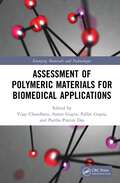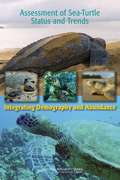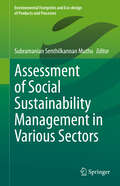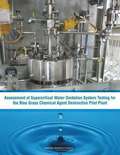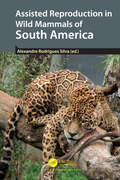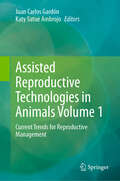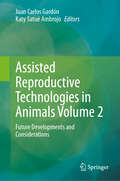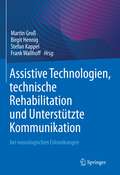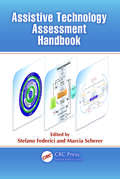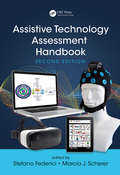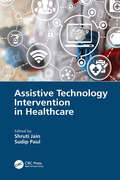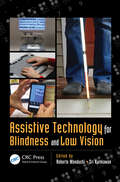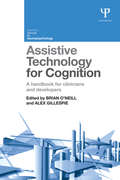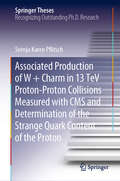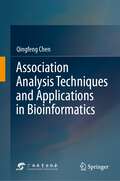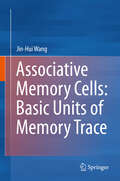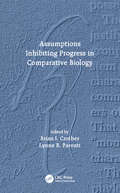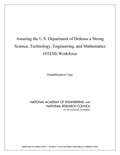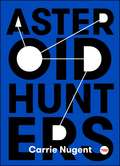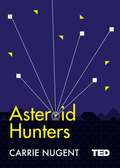- Table View
- List View
Assessment of Polymeric Materials for Biomedical Applications (Emerging Materials and Technologies)
by Sumit Gupta Pallav Gupta Partha Pratim Das Vijay ChaudharyThis book initiates with an introduction to polymeric materials, followed by various classifications and properties of polymeric implant material including various development methods of polymeric materials and their characterization techniques. An overview of various toxicology assessments of polymeric materials and polymeric materials for drug delivery system is also included. Design and analysis of polymeric materials-based components using Ansys software along with polymeric materials for additively manufactured artificial organs are also discussed. Features: Addresses assessment of polymeric materials in biomedical sciences, including classification, properties, and development of polymeric implants. Covers various topics in the field of tissue regeneration. Discusses biocompatibility, toxicity, and biodegradation of polymeric materials. Explores wide-scale characterization to study the effect of inclusion size on the mechanical properties of polymeric materials. Reviews limitations and future directions on polymeric material with emphasis on biocompatibility. This book is aimed at graduate students and researchers in biomaterials, biomedical engineering, composites, and polymers.
Assessment of Sea-Turtle Status and Trends: Integrating Demography and Abundance
by National Research Council of the National AcademiesAll six species of sea turtles found in U.S. waters are listed as endangered or threatened, but the exact population sizes of these species are unknown due to a lack of key information regarding birth and survival rates. The U.S. Endangered Species Act prohibits the hunting of sea turtles and reduces incidental losses from activities such as shrimp trawling and development on beaches used for nesting. However, current monitoring does not provide enough information on sea turtle populations to evaluate the effectiveness of these protective measures. Sea Turtle Status and Trends reviews current methods for assessing sea turtle populations and finds that although counts of sea turtles are essential, more detailed information on sea turtle biology, such as survival rates and breeding patterns, is needed to predict and understand changes in populations in order to develop successful management and conservation plans.
Assessment of Social Sustainability Management in Various Sectors (Environmental Footprints and Eco-design of Products and Processes)
by Subramanian Senthilkannan MuthuThis volume presents a variety of case studies detailing how imperatives of social sustainability are handled in several industries. The first chapter written by the volume editor provides context for social sustainability and explains how the following chapters fit together. The following five chapters detail cases from the textile industry, technology firms, agriculture, and the healthcare industry.
Assessment of Supercritical Water Oxidation System Testing for the Blue Grass Chemical Agent Destruction Pilot Plant
by National Research Council Board on Army Science and Technology Division on Engineering and Physical Sciences Committee to Assess Supercritical Water Oxidation System Testing for the Blue Grass Chemical Agent Destruction Pilot PlantAssessment of Supercritical Water Oxidation System Testing for the Blue Grass Chemical Agent Destruction Pilot Plant reviews and evaluates the results of the tests conducted on one of the SCWO units to be provided to Blue Grass Chemical Agent Destruction Pilot Plant. The Army Element, Assembled Chemical Weapons Alternatives (ACWA) is responsible for managing the conduct of destruction operations for the remaining 10 percent of the nation's chemical agent stockpile, stored at the Blue Grass Army Depot (Kentucky) and the Pueblo Chemical Depot (Colorado). Facilities to destroy the agents and their associated munitions are currently being constructed at these sites. The Blue Grass Chemical Agent Destruction Pilot Plant (BGCAPP) will destroy chemical agent and some associated energetic materials by a process of chemical neutralization known as hydrolysis. The resulting chemical waste stream is known as hydrolysate. Among the first-of-a-kind equipment to be installed at BGCAPP are three supercritical water oxidation (SCWO) reactor systems. These particular hydrolysate feeds present unique non-agent-related challenges to subsequent processing via SCWO due to their caustic nature and issues of salt management.This report provides recommendations on SCWO systemization testing inclusive of durability testing and discusses systemization testing objectives and concepts.
Assessment of the AHRQ Patient Safety Initiative
by Michael D. Greenberg Cheryl L. Damberg Donna O. Farley Melony E. Sorbero M. Susan RidgelyUpdates the policy context of the Agency for Healthcare Research and Quality (AHRQ) patient safety initiative; documents the current priorities and activities undertaken; and assesses contributions of health information technology projects and dissemination actions to support adoption of evidence-based safe practices. Discusses implications for future AHRQ policy, programming, and research; suggests ways to strengthen AHRQ activities.
Assessment of the Fate of Surrogates for Enteric Pathogens Resulting From the Surcharging of Combined Sewer Systems (IHE Delft PhD Thesis Series)
by Iosif Marios ScoullosIn the last ten years (2009-2019), flooding caused the death of over 48,000 people, and affected over 697 million people globally. This is expected to increase as a result of climate change, population growth and urbanisation. Floods can cause infections due to the release of water-borne pathogens from surcharged combined sewers and other sources of faecal contamination on urban surfaces such as concrete, asphalt, gravel, pavement, playground rubber tiles and grass. Using laboratory experiments with faecal indicator bacteria Escherichia coli, and with Bacillus subtilis spores, and MS2 bacteriophages under controlled exposure to simulated sunlight, this research contributes towards a better understanding of the environmental parameters that affect the concentration of pathogens in contaminated shallow water bodies and on different urban surfaces. Also, several sampling methods are assessed for the recovery of bacteria from flood-prone urban surfaces. This study suggests that given the sunlight conditions after an urban flood, the concentration of indicator organisms and of total suspended solids and the surface type it is possible to estimate the fate of selected pathogens. The observations and results presented in this study contribute to the development of policy-making tools for rapid implementation of appropriate measures to mitigate public health risks after flooding. This book:- highlights the relation of urban floods with water-borne diseases.-stresses for the first time the importance of urban surfaces (pavement, concrete, asphalt, etc.) on the inactivation of water-borne pathogens.-provides equations that can be used to develop policy-making tools for implementation of appropriate measures to mitigate public health risks after flooding.
Assessment of the Results of External Independent Reviews for U.S. Department of Energy Projects
by National Research Council of the National AcademiesThe National Academies Press (NAP)--publisher for the National Academies--publishes more than 200 books a year offering the most authoritative views, definitive information, and groundbreaking recommendations on a wide range of topics in science, engineering, and health. Our books are unique in that they are authored by the nation's leading experts in every scientific field.
Assigning Structures to Ions in Mass Spectrometry
by John L. Holmes Christiane Aubry Paul M. MayerAssigning Structures to Ions in Mass Spectrometry describes the tools currently available for determining gas-phase ion structures. It surveys current experimental methods for ion production and separation as well as those designed to reveal qualitative and quantitative aspects of gas-phase ions. It also examines how and when to apply computational chemistry and theoretical calculations. Selected case studies illustrate specific challenges associated with ion structure assignment and thermochemical problems. Bringing together key results collected over the past four decades, the book contains the data for describing or identifying ions containing C alone and C with H, O, N, S, P, halogens, and small organic cations.
Assisted Reproduction in Wild Mammals of South America
by Alexandre Rodrigues SilvaSouth America has one of the greatest riches in the world in terms of biodiversity. Despite all this richness, recent reports warn of different threats to this biodiversity. As a strategy to reduce the rate of loss of animal species, the development and application of assisted reproduction techniques (ARTs) for their conservation currently stands out. Thus, this book compiles information on recent scientific studies regarding the development of ARTs for the conservation of wild mammalian species in South America, thus serving as an important source of reference for professionals and students interested in wildlife conservation.
Assisted Reproductive Technologies in Animals Volume 1: Current Trends for Reproductive Management
by Juan Carlos Gardón Katy Satué AmbrojoThis Volume 1 of a two-volume topical collection highlights reproductive biotechnologies applied to males and females of different animal species. Organized in five parts, you will find a detailed review of the most relevant topics for reproduction management in equines, cattle, swine, and small ruminants. The authors discuss genomic selection, the use of ultrasound, sperm evaluation and conservation, oocyte retrieval, embryonic development, and significant clinical aspects such as stress and physiological impacts, including thermal conditions. Each contributor brings an own perspective, knowledge, and writing style, resulting in the latest research results, advances, and current trends in assisted reproductive technologies. The volume also includes case studies and hands-on examples to provide readers with real-life applications. The practical approach will enhance the learning experience and differentiates this work from mainly theoretical literature. Specifically tailored to the professional audience within the field of assisted animal reproduction, this book will update veterinarians, researchers, animal breeders, and advanced students. By presenting innovative techniques and approaches not widely covered in other works, this volume offers new perspectives and ideas for reproductive management.
Assisted Reproductive Technologies in Animals Volume 2: Future Developments and Considerations
by Juan Carlos Gardón Katy Satué AmbrojoThis Volume 2 of a two-volume topical collection highlights reproductive biotechnologies applied to males and females of different animal species. Organized in two parts, you will find a detailed review of the latest developments in reproduction management for equines, cattle, swine, and birds. The authors discuss the application of ultrasonography, equine cloning, animal germplasm banks, the captive breeding of threatened wild birds, as well as nanotechnologies and artificial intelligence. Vivid illustrations complement the rich information. Each contributor brings an own perspective, knowledge, and writing style, resulting in the latest research results, advances, and current trends in assisted reproductive technologies. The work also includes case studies and hands-on examples to provide readers with real-life applications. The practical approach will enhance the learning experience and differentiates this volume from mainly theoretical literature. Specifically tailored to the professional audience within the field of assisted animal reproduction, this book will update veterinarians, researchers, animal breeders, and advanced students. By presenting innovative techniques and approaches not widely covered in other works, this volume offers new perspectives and ideas for reproductive management.
Assistive Technologien, technische Rehabilitation und Unterstützte Kommunikation: bei neurologischen Erkrankungen
by Martin Groß Birgit Hennig Stefan Kappel Frank WallhoffDas interdisziplinäre Grundlagenwerk informiert aus der Perspektive von Neurologie, Rehabilitation, Ingenieurwesen, Pädagogik und Physiotherapie sowie aus Sicht der Patienten über Möglichkeiten und Grenzen des Einsatzes von Technik, um die Teilhabe neurologisch erkrankter Menschen zu verbessern. Ziel des Buches ist, allen Berufsgruppen, die an der Behandlung schwer und komplex erkrankter neurologischer Patienten beteiligt sind, ein umfassendes Verständnis assistiver und rehabilitativer Technologien zu vermitteln.
Assistive Technology Assessment Handbook (Rehabilitation Science in Practice Series)
by Marcia J. Scherer Stefano FedericiThe process of matching a person who has a disability with the most appropriate assistive technology requires a series of assessments, typically administered by multidisciplinary teams at specialized centers for technical aid. Assistive Technology Assessment Handbook fills the need for a reference that helps assistive technology experts perform ass
Assistive Technology Assessment Handbook (Rehabilitation Science in Practice Series)
by Marcia Scherer Stefano FedericiAssistive Technology Assessment Handbook, Second Edition, proposes an international ideal model for the assistive technology assessment process, outlining how this model can be applied in practice to re-conceptualize the phases of an assistive technology delivery system according to the biopsychosocial model of disability. The model provides reference guidelines for evidence-based practice, guiding both public and private centers that wish to compare, evaluate, and improve their ability to match a person with the correct technology model. This second edition also offers a contribution to the Global Cooperation on Assistive Technology (GATE) initiative, whose activities are strongly focused on the assistive products service delivery model. Organized into three parts, the handbook: gives readers a toolkit for performing assessments; describes the roles of the assessment team members, among them the new profession of psychotechnologist; and reviews technologies for rehabilitation and independent living, including brain–computer interfaces, exoskeletons, and technologies for music therapy. Edited by Stefano Federici and Marcia J. Scherer, this cross-cultural handbook includes contributions from leading experts across five continents, offering a framework for future practice and research.
Assistive Technology Intervention in Healthcare
by Sudip Paul Shruti JainAssistive Technology Intervention in Healthcare focuses on various applications of intelligent techniques in biomedical engineering and health informatics. It aims to create awareness about disability reduction and recovery of accidental disability with the help of various rehabilitative systems. Novel technologies in disability treatment, management and assistance, including healthcare devices and their utility from home to hospital, are described. The book deals with simulation, modeling, measurement, control, analysis, information extraction and monitoring of physiological data in clinical medicine and biology. Features Covers the latest evolutionary approaches to solve optimization problems in the biomedical engineering field Explains machine learning–based approaches to improvement in health engineering areas Reviews the IoT, cloud computing and data analytics in healthcare informatics Discusses modeling and simulations in the design of biomedical equipment Explores monitoring of physiological data This book is aimed at researchers and graduate students in biomedical engineering, clinical engineering and bioinformatics.
Assistive Technology for Blindness and Low Vision (Rehabilitation Science in Practice Series)
by Roberto Manduchi Sri KurniawanAssistive technology has made it feasible for individuals with a wide range of impairments to engage in many activities, such as education and employment, in ways not previously possible. The key factor is to create consumer-driven technologies that solve the problems by addressing the needs of persons with visual impairments. Assistive Technology for Blindness and Low Vision explores a broad range of technologies that are improving the lives of these individuals. Presenting the current state of the art, this book emphasizes what can be learned from past successful products, as well as what exciting new solutions the future holds.Written by world-class leaders in their field, the chapters cover the physiological bases of vision loss and the fundamentals of orientation, mobility, and information access for blind and low vision individuals. They discuss technology for multiple applications (mobility, wayfinding, information access, education, work, entertainment), including both established technology and cutting-edge research. The book also examines computer and digital media access and the scientific basis for the theory and practice of sensory substitution.This volume provides a holistic view of the elements to consider when designing assistive technology for persons with visual impairment, keeping in mind the need for a user-driven approach to successfully design products that are easy to use, well priced, and fill a specific need. Written for a broad audience, this book provides a comprehensive overview and in-depth descriptions of current technology for designers, engineers, practitioners, rehabilitation professionals, and all readers interested in the challenges and promises of creating successful assistive technology.
Assistive Technology for Cognition: A handbook for clinicians and developers (Current Issues in Neuropsychology)
by Brian O'Neill Alex GillespieAssistive technology for cognition is technology which can be used to enable, enhance, or extend cognitive function. This book systematically examines how cutting-edge digital technologies can assist the cognitive function of people with cognitive impairments, with the potential to revolutionize rehabilitation. Technologies are reviewed which direct attention, remind, recognize, prompt, and generally guide people through activities of daily living. Written by experts in neuropsychology and technology development, Assistive Technology for Cognition provides a comprehensive overview of the efficacy of technologies to assist people with brain impairments. Based on the list provided by the International Classification of Function, each chapter covers a different cognitive function; namely, attention, memory, affect, perception, executive function, language, numeracy, sequencing, and navigation onto which existing and future assistive technologies for cognition are mapped. This structure provides in-depth research in an accessible way, and will allow practitioners to move from an assessment of cognitive deficits to the prescription of an appropriate assistive technology for cognition. The chapters also make suggestions for future developments. Assistive Technology for Cognition will be of great interest to clinicians and researchers working in brain injury rehabilitation, technology developers, and also to students in clinical psychology, neuropsychology, and allied health disciplines.
Associated Production of W + Charm in 13 TeV Proton-Proton Collisions Measured with CMS and Determination of the Strange Quark Content of the Proton (Springer Theses)
by Svenja Karen PflitschThe associated production of a W boson and a single charm quark (W+c) is the only process in proton-proton collisions that directly probes the strange quark content of the proton. In this thesis, W+charm production is measured in proton-proton collisions at the LHC at 13 TeV, as recorded by the Compact Muon Solenoid (CMS) experiment. The analysis focuses on the identification of W bosons in their leptonic decay to a muon and a neutrino and charm quarks are tagged via the full reconstruction of D*-Mesons.The measured cross sections of W+c production are used, in combination with other relevant CMS results and the most precise HERA DIS data, in a QCD analysis to determine the strange quark content of the proton. The resulting strange quark distribution and suppression, with respect to the other light sea quarks, are in good agreement with those obtained in neutrino scattering experiments and extend their kinematic reach.
Association Analysis Techniques and Applications in Bioinformatics
by Qingfeng ChenAdvances in experimental technologies have given rise to tremendous amounts of biology data. This not only offers valuable sources of data to help understand biological evolution and functional mechanisms, but also poses challenges for accurate and effective data analysis. This book offers an essential introduction to the theoretical and practical aspects of association analysis, including data pre-processing, data mining methods/algorithms, and tools that are widely applied for computational biology. It covers significant recent advances in the field, both foundational and application-oriented, helping readers understand the basic principles and emerging techniques used to discover interesting association patterns in diverse and heterogeneous biology data, such as structure-function correlations, and complex networks with gene/protein regulation. The main results and approaches are described in an easy-to-follow way and accompanied by sufficientreferences and suggestions for future research. This carefully edited monograph is intended to provide investigators in the fields of data mining, machine learning, artificial intelligence, and bioinformatics with a profound guide to the role of association analysis in computational biology. It is also very useful as a general source of information on association analysis, and as an overall accompanying course book and self-study material for graduate students and researchers in both computer science and bioinformatics.
Associative Memory Cells: Basic Units of Memory Trace
by Jin-Hui WangThis book focuses on associative memory cells and their working principles, which can be applied to associative memories and memory-relevant cognitions. Providing comprehensive diagrams, it presents the author's personal perspectives on pathology and therapeutic strategies for memory deficits in patients suffering from neurological diseases and psychiatric disorders. Associative learning is a common approach to acquire multiple associated signals, including knowledge, experiences and skills from natural environments or social interaction. The identification of the cellular and molecular mechanisms underlying associative memory is important in furthering our understanding of the principles of memory formation and memory-relevant behaviors as well as in developing therapeutic strategies that enhance memory capacity in healthy individuals and improve memory deficit in patients suffering from neurological disease and psychiatric disorders. Although a series of hypotheses about neural substrates for associative memory has been proposed, numerous questions still need to be addressed, especially the basic units and their working principle in engrams and circuits specific for various memory patterns. This book summarizes the developments concerning associative memory cells reported in current and past literature, providing a valuable overview of the field for neuroscientists, psychologists and students.
Assuming the Ecosexual Position: The Earth as Lover
by Annie Sprinkle Jennie Klein Beth StephensThe story of the artistic collaboration between the originators of the ecosex movement, their diverse communities, and the Earth What&’s sexy about saving the planet? Funny you should ask. Because that is precisely—or, perhaps, broadly—what Annie Sprinkle and Beth Stephens have spent many years bringing to light in their live art, exhibitions, and films. In 2008, Sprinkle and Stephens married the Earth, which set them on the path to explore the realms of ecosexuality as they became lovers with the Earth and made their mutual pleasure an embodied expression of passion for the environment. Ever since, they have been not just pushing but obliterating the boundaries circumscribing biology and ecology, creating ecosexual art in their performance of an environmentalism that is feminist, queer, sensual, sexual, posthuman, materialist, exuberant, and steeped in humor.Assuming the Ecosexual Position tells of childhood moments that pointed to a future of ecosexuality—for Annie, in her family swimming pool in Los Angeles; for Beth, savoring forbidden tomatoes from the vine on her grandparents&’ Appalachian farm. The book describes how the two came together as lovers and collaborators, how they took a stand against homophobia and xenophobia, and how this union led to the miraculous conception of the Love Art Laboratory, which involved influential performance artists Linda M. Montano, Guillermo Gómez-Peña, and feminist pornographer Madison Young. Stephens and Sprinkle share the process of making interactive performance art, including the Chemo Fashion Show, Cuddle, Sidewalk Sex Clinics, and Ecosex Walking Tours. Over the years, they celebrated many more weddings to various nature entities, from the Appalachian Mountains to the Adriatic Sea. To create these weddings, they collaborated with hundreds of people and invited thousands of guests as they vowed to love, honor, and cherish the many elements of the Earth.As entertaining as it is deeply serious, and arriving at a perilous time of sharp differences and constricting categories, the story of this artistic collaboration between Sprinkle, Stephens, their diverse communities, and the Earth opens gender and sexuality, art and environmentalism, to the infinite possibilities and promise of love.
Assumptions Inhibiting Progress in Comparative Biology
by Brian I. Crother & Lynne R. ParentiThis book is a thought-provoking assessment of assumptions inhibiting progress in comparative biology. The volume is inspired by a list generated years earlier by Donn Rosen, one of the most influential, innovative and productive comparative biologists of the latter 20th century. His list has assumed almost legendary status among comparative evolutionary biologists. Surprisingly many of the obstructing assumptions implicated by Rosen remain relevant today. Any comparative biologist hoping to avoid such assumptions in their own research will benefit from this introspective volume.
Assuring the U.S. Department of Defense a Strong Science, Technology, Engineering, and Mathematics (STEM) Workforce
by National Research Council National Academy of Engineering Division on Engineering and Physical Sciences Policy and Global Affairs Board on Higher Education and Workforce Committee on Science, Technology, Engineering, and Mathematics Workforce Needs for the U.S. Department of Defense and the U.S. Defense Industrial BaseThe ability of the nation's military to prevail during future conflicts, and to fulfill its humanitarian and other missions, depends on continued advances in the nation's technology base. A workforce with robust Science, Technology, Engineering and Mathematics (STEM) capabilities is critical to sustaining U.S. preeminence. Today, however, the STEM activities of the Department of Defense (DOD) are a small and diminishing part of the nation's overall science and engineering enterprise. Assuring the U.S. Department of Defense a Strong Science, Technology, Engineering, and Mathematics (STEM) Workforce presents five principal recommendations for attracting, retaining, and managing highly qualified STEM talent within the department based on an examination of the current STEM workforce of DOD and the defense industrial base. As outlined in the report, DOD should focus its investments to ensure that STEM competencies in all potentially critical, emerging topical areas are maintained at least at a basic level within the department and its industrial and university bases.
Asteroid Hunters (TED Books)
by Carrie NugentFor the first time, scientists could have the knowledge to prevent a natural disaster epic in scale—an asteroid hitting the earth and in this exciting, adventuresome book, Carrie Nugent explains how.What are asteroids, and where do they come from? And, most urgently: Are they going to hit the Earth? What would happen if one was on its way? Carrie Nugent is an asteroid hunter—part of a group of scientists working to map our cosmic neighborhood. For the first time ever, we are reaching the point where we may be able to prevent the horrible natural disaster that would result from an asteroid collision. In Asteroid Hunters, Nugent reveals what known impact asteroids have had: the extinction of the dinosaurs, the earth-sized hole Shoemaker Levy 9 left in Jupiter just a few decades ago, how the meteorite that bursted over Chelyabinsk in Russia could have started a war, and unlucky Ms. Anne Hodges—the only person (that we know of) in US history to be the victim of a direct hit. Nugent also introduces the telescope she uses to detect near-Earth asteroids. Ultimately, detection is the key to preventing asteroid impact, and these specialized scientists are working to prevent the unthinkable from happening. If successful, asteroid hunting will lead to the first natural disaster humans have the know-how and the technology to prevent. The successful hunt and mapping of asteroids could mean nothing less than saving life on earth.
Asteroid Hunters (Ted Bks.)
by Carrie NugentDr Carrie Nugent is an asteroid hunter - one of the select group of scientists working diligently to map our cosmic neighbourhood. For the first time ever we are reaching the point where we may be able to prevent a natural disaster resulting from an asteroid collision. Nugent will delve into the impact asteroids have had in the past: the extinction of the dinosaurs, the earth-sized hole Shoemaker-Levy 9 left in Jupiter just a few years ago, how the surprise hit on Chelyabinsk in Russia could have started a war and unlucky Ms Anne Hodges - the only person (that we know of) in modern history to be the victim of a direct hit. Nugent will also reveal the cutting-edge work that she is part of - using NASA's NEOWISE telescope to track down near-Earth asteroids. NEOWISE has seen over 158,000 asteroids and discovered over 30,000. We will also get a rare glimpse into the work of this band of asteroid hunters and their techniques. Asteroid orbits are chaotic which means a small early change has a big impact later on. The successful hunt and mapping of asteroids could mean nothing less than saving life on Earth.
